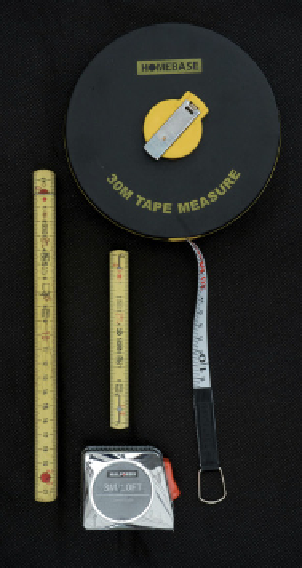Geoscience Reference
In-Depth Information
2.5 Measuring distance and thickness
1
Thickness and distance are two of the most basic measurements
that need to be made for many geological tasks. For most of
them a tape measure or folding ruler (Figure 2.13) will suffi ce
but when working on slopes a Jacob staff and compass-
clinometer can be useful (Section 2.5.2).
2
2.5.1 Standard thickness and
distance measurements
A surveyor's 30 m tape is useful for large-scale measurements,
for instance during regional mapping (Section 10.2.2; Figure
2.13, item 1). Smaller, shorter and much cheaper, 2 or 5 or 10 m
length, retracting metal-tape measures (Figure 2.13, item 4) are,
however, perfectly adequate for small-scale work and for graphic
logging (Section 6.3). The retracting metal-tape measures also
have the advantage that they are stiff and therefore can be used
much more easily to obtain an accurate measurement of the
thickness of the bed by holding it perpendicular to the bedding.
Folding plastic metric rulers that extend to 1 m or 2 m can be
obtained in some countries and are very useful as a scale for
photographs and for graphic logging (Figure 2.13, items 2 and 3).
These stiff rulers can easily be used to measure the thickness of
partially submerged beds, for instance in a rock pool on the
foreshore, and can be held at the bottom and pointed up cliffs to
measure the thickness of otherwise inaccessible beds. They are
also much easier to use when measuring on your own because
the thickness of beds that are greater than that of your arm span
can be measured. A pole of known length or a long steel rule or
wooden rule can also be used for this purpose and for general
measurements (Figure 2.13b). When measuring the dimension of
a geological feature it is important to ensure that you have not
overestimated the distance by placing the tape oblique to the
bedding plane. For instance, in Figure 1.1a to obtain a true
thickness the top of the tape would need to be placed closer to
the bed so that it was perpendicular to the bedding plane.
2
3
4
(a)
(b)
When dipping rocks are exposed on a horizontal surface only
(e.g. on a quarry fl oor, in a stream section or in the foreshore) it
is very diffi cult or impossible to measure directly a true bed
thickness. By measuring the horizontal distance perpendicular
to strike (
d
) and the angle of dip of the beds (
Figure 2.13
(a) A variety of
useful tape measures for fi eld use:
1, surveyor's tape; 2, folding rule;
3, 1 m folding rule; 4, retracting
metal-tape measure. (b) Home-
made wooden pole with decimetre
graduations to give a general idea
of scale.
) this can be
solved (Figure 2.14). The true thickness is given by the
equation:
θ
True thickness =×
d
sinθ
This technique can be used to obtain a very good estimate of
the thickness of beds, to estimate the distance over which beds
are not exposed (for instance on the foreshore between resistant









